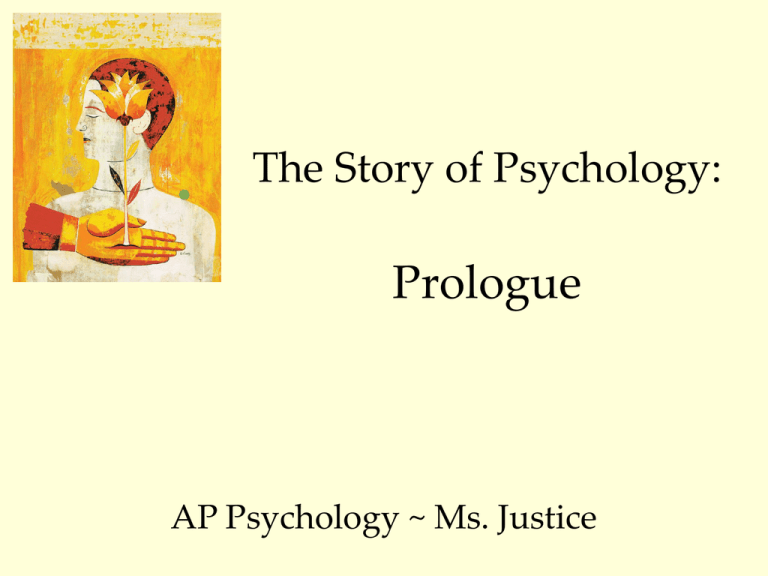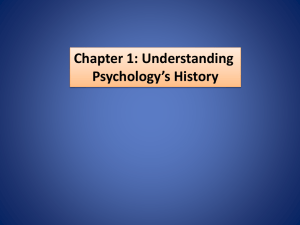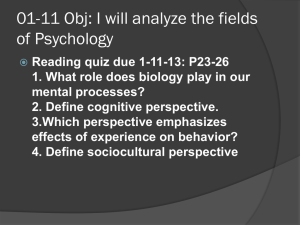Psychology in Everday Life David Myers
advertisement

The Story of Psychology: Prologue AP Psychology ~ Ms. Justice BIG IDEAS What is Psychology? 1: When and how did psychological science begin? 2: How did psychology develop from the 1920s through today? Contemporary Psychology 3: What is psychology’s historic big issue? 4: What are psychology’s levels of analysis and related perspectives? 5: What are psychology’s main subfields? 6: How can psychological principles help you as a student? What is Psychology? Psychology is a science that seeks to answer questions about how and why we think, feel, and act as we do. Psychology vs. Pseudo-psychology •With hopes of satisfying curiosity, many people listen to talk-radio counselors and psychics to learn about others and themselves. •However, real psychological insights are more interesting and helpful. •Pseudo-psychology also produces fraud, which can lead to diminished public support for legitimate psychological science. http://www.photovault.com http://www.nbc.com Dr. Crane (radio-shrink) Psychic (Ball gazing) 1: When and how did psychological science begin? Aristotle (384-322 B.C.) http://faculty.washington.edu Aristotle, a naturalist and philosopher, theorized about psychology’s concepts. He suggested that the soul and body are not separate and that knowledge grows from experience. Wundt (1832-1920) Psychological Science is Born… Wilhelm Wundt and psychology’s first graduate students studied the “atoms of the mind” by conducting experiments at Leipzig, Germany, in 1879. This work is considered the birth of psychology as we know it today. Wundt’s student, Edward Bradford Titchener introduced structuralism. In an effort to discover the structural elements of the mind, he engaged people in self-reflective introspection and trained them to report elements of their experience. The results varied from person to person and were unreliable. Mary Calkins James (1842-1910) American philosopher William James wrote the first psychology textbook in 1890, Principles of Psychology. James was a functionalist, who studied how our mental and behavioral processes function ; how they enable us to adapt, survive, and flourish. Mary Calkins, James’s student, became the APA’s first female president. 2: How did psychology develop from the 1920s through today? Freud (1856-1939) Sigmund Freud, an Austrian physician, and his followers emphasized the importance of the unconscious mind and its effects on human behavior. Freud’s theories were unscientific and unverifiable, though some of his basic ideas are still used by therapists today Watson (1878-1958) Skinner (1904-1990) Behaviorists John B. Watson and B. F. Skinner dismissed introspection and emphasized the study of overt behavior as the subject matter of scientific psychology. You cannot observe a sensation, feeling, or thought, but you can observe and record behavior in response to different situations. http://facultyweb.cortland.edu http://www.carlrogers.dk Maslow (1908-1970) Humanistic Psychology Rogers (1902-1987) Abraham Maslow and Carl Rogers rebelled against Freudian psychology and behaviorism They emphasized current environmental influences on our growth potential, and our need for love and acceptance. •In the 1960s a new movement, cognitive psychology, emerged as psychology began to recapture its initial interest in mental processes and how our mind retains information •More recently, cognitive neuroscience has combined the study of brain activity with cognition (perception, thinking, memory, and language) •We define psychology today as the scientific study of behavior (what we do) and mental processes (inner thoughts and feelings). 3: What is psychology’s historic big issue? Contemporary Psychology The nature-nurture issue – the controversy over the relative contributions of biology and experience •Origins of the issue are ancient and have been debated throughout history by Plato (nature), Aristotle (nurture), Locke (nurture), and Descartes (nature) •Charles Darwin’s idea of natural selection impacted the nature-nurture discussion as well. He proposed that among the range of inherited trait variations, those that contribute to reproduction and survival will most likely be passed on to the succeeding generations •Today’s science sees traits and behaviors arising from the interaction of nature and nurture 4: What are psychology’s levels of analysis and related perspectives? Figure 1, page 8 Biopsychosocial approach – integrates these three influences Psychology’s Current Perspectives • Humanist Perspective – believes that we choose most of our behaviors and these choices are guided by physiological, emotional, and spiritual needs. • Psychoanalytic/Psychodynamic Perspective – believes that the unconscious mind controls much of our thought and action (impulses, repressed memories, etc.) • Biological/Neuroscience Perspective - explains thought and behavior in terms of biological processes (cognition and reactions caused by genes, hormones, neurotransmitters, etc.) Most current psychologists draw from multiple perspectives. Psychology’s Current Perspectives • Evolutionary Perspective – explains thought and behavior in terms of natural selection; psychological traits that are advantageous for survival get passed down • Behavioral Perspective - explains human thought and behavior in terms of conditioning; looks strictly at observable behavior and reactions to specific behaviors Most current psychologists draw from multiple perspectives. Psychology’s Current Perspectives • Cognitive Perspective - examines human thought and behavior in terms of how we interpret, process, and remember environmental events • Social-Cultural/Sociocultural Perspective examines human thought and behavior in terms of variations in cultures Most current psychologists draw from multiple perspectives. 5: What are psychology’s main subfields? Psychology’s Subfields: Research Some psychologists conduct basic research that builds psychology’s knowledge base. Psychologist Biological Developmental Cognitive Personality Social What he/she does Explore the links between brain and mind. Study changing abilities from womb to tomb. Study how we perceive, think, and solve problems. Investigate our persistent traits. Explore how we view and affect one another. Psychology’s Subfields: Research Other 11.5% Experimental 14.1% Biological 9.9% Developmental 24.6% Psychometrics 5.5% Cognitive 8.0% Social 21.6% Personality 4.8% Data: APA 1997 Psychology’s Subfields: Applied Some psychologists conduct basic research that builds psychology’s knowledge base. Psychologist What he/she does Clinical Studies, assesses, and treats people with psychological disorders Counseling Helps people cope with academic, vocational, and marital challenges. Educational Studies and helps individuals in school and educational settings Industrial/ Organizational Studies and advises on behavior in the workplace. Psychology’s Subfields: Applied Industrial 6% Educational 9% Other 3% Counseling 15% Clinical 67% Data: APA 1997 Clinical Psychology vs. Psychiatry A clinical psychologist (Ph.D.) studies, assesses, and treats troubled people with psychotherapy. Psychiatrists on the other hand are medical professionals (M.D.) who use treatments like drugs and psychotherapy to treat psychologically diseased patients.








